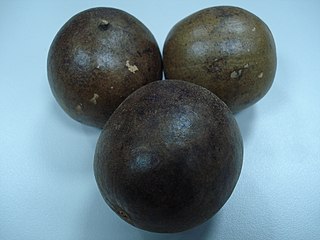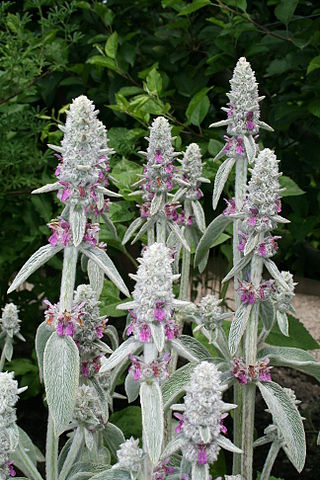
Spearmint, a species of mint (mentha) scientifically classified as Mentha spicata (,) also known as garden mint, common mint, lamb mint and mackerel mint, is native to Europe and southern temperate Asia, extending from Ireland in the west to southern China in the east. It is naturalized in many other temperate parts of the world, including northern and southern Africa, North America, and South America. It is used as a flavouring in food and herbal teas. The aromatic oil, called oil of spearmint, is also used as a flavoring and sometimes as a scent.

A vine is any plant with a growth habit of trailing or scandent stems, lianas, or runners. The word vine can also refer to such stems or runners themselves, for instance, when used in wicker work.

Prunus is a genus of trees and shrubs, which includes the fruits plums, cherries, peaches, nectarines, apricots, and almonds.

Clematis is a genus of about 380 species within the buttercup family, Ranunculaceae. Their garden hybrids and cultivars have been popular among gardeners, beginning with Clematis 'Jackmanii', a garden staple since 1862; more cultivars are being produced constantly. They are mainly of Chinese and Japanese origin.

Passiflora, known also as the passion flowers or passion vines, is a genus of about 550 species of flowering plants, the type genus of the family Passifloraceae.

Monstera deliciosa, the Swiss cheese plant or split-leaf philodendron is a species of flowering plant native to tropical forests of southern Mexico, south to Panama. It has been introduced to many tropical areas, and has become a mildly invasive species in Hawaii, Seychelles, Ascension Island and the Society Islands. It is very widely grown in temperate zones as a houseplant.

Berberis, commonly known as barberry, is a large genus of deciduous and evergreen shrubs from 1–5 m (3.3–16.4 ft) tall, found throughout temperate and subtropical regions of the world. Species diversity is greatest in South America and Asia; Europe, Africa and North America have native species as well. The best-known Berberis species is the European barberry, Berberis vulgaris, which is common in Europe, North Africa, the Middle East, and central Asia, and has been widely introduced in North America. Many of the species have spines on the shoots and all along the margins of the leaves.

Passiflora foetida is a species of passion flower that is native to the southwestern United States, Mexico, the Caribbean, Central America, and much of South America. It has been introduced to tropical regions around the world, such as Southeast Asia, South Asia, Hawaii, Africa, and The Maldives. It is a creeping vine like other members of the genus, and yields an edible fruit. The specific epithet, foetida, means "stinking" in Latin and refers to the strong aroma emitted by damaged foliage.

Prunus salicina, commonly called the Japanese plum or Chinese plum, is a small deciduous tree native to China. It is now also grown in fruit orchards in Vietnam, Korea, Japan, Israel, the United States, and Australia.

Akebia is a genus of five species of flowering plant, within the family Lardizabalaceae. The scientific name, akebia, is a Latinization of the Japanese name for the species Akebia quinata: akebi (通草).

Akebia quinata, commonly known as chocolate vine, five-leaf chocolate vine, or five-leaf akebia, is a shrub that is native to Japan, China and Korea, commonly used as an ornamental / edible plant in the United States and Europe In its native habitat, it is often found on hills, in hedges, on trees, along forest edges and streams, and on mountainous slopes.

Siraitia grosvenorii, also known as monk fruit, monkfruit or luohan guo, is a herbaceous perennial vine of the gourd family, Cucurbitaceae. It is native to southern China. The plant is cultivated for its fruit extract, called mogrosides, which creates a sweetness sensation 250 times stronger than sucrose. Mogroside extract has been used as a low-calorie sweetener for drinks and in traditional Chinese medicine.

Calendula officinalis, the pot marigold, common marigold, ruddles, Mary's gold or Scotch marigold, is a flowering plant in the daisy family Asteraceae. It is probably native to southern Europe, though its long history of cultivation makes its precise origin unknown, and it may possibly be of garden origin. It is also widely naturalised farther north in Europe and elsewhere in warm temperate regions of the world.

Stachys byzantina, the lamb's-ear or woolly hedgenettle, is a species of flowering plant in the mint family Lamiaceae, native to Armenia, Iran, and Turkey. It is cultivated throughout much of the temperate world as an ornamental plant, and is naturalised in some locations as an escapee from gardens. Plants are very often found under the synonym Stachys lanata or Stachys olympica.

Boquila is a monotypic genus of flowering plants in the family Lardizabalaceae, endemic to temperate forests of central and southern Chile and Argentina. The sole species is Boquila trifoliolata, the chameleon vine. The sole member of this genus was first described in 1782 by Juan Ignacio Molina, and the genus itself was established in 1839 by Joseph Decaisne. B. trifoliata forms non-parasitic vines that wind around host plants, using them for structure and protection. B. trifoliata is monoecious, and its flowers are an off white color. It bears an edible fruit and has been historically used in rope and basket making.

Flacourtia indica (known commonly as ramontchi, governor's plum and Indian plum, is a species of flowering plant native to much of Africa and tropical and temperate parts of Asia. It has various uses, including folk medicine, fuel, animal food and human food.

Litsea garciae, also known as engkala, engkalak, kangkala, pangalaban, and Borneo avocado, is a flowering tree in the family Lauraceae. It is native to Taiwan, the Philippines, Borneo, the Malay Peninsula, Sumatra, Java, and Sulawesi.

Akebia longeracemosa or long-racemed akebia is a member of the chocolate vine genus, Akebia, and more specifically a relative of the commonly known, Akebia quinata.

Akebia chingshuiensis is a member of the Akebia family native to China. It is a rarer species of Akebia and has a smaller range than Akebia trifoliata or Akebia quinata.

Akebia apetala is a species of flowering plant in the Lardizabalaceae family. It has only been found in Northwestern China.
























